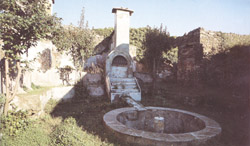
HOUSE OF M. LUCRETIUS - POMPEII

This house is attributed to M. Lucretius because his name appears as addressee on a letter depicted, with a kit for writing letters, in a wall painting in a room near the garden. He was an important figure who held the office of decurion in the city and was a priest of Mars. This patrician house had fine wall paintings, now mostly in the Archaeological Museum in Naples. In the atrium there are still some frescoes in IV style with imaginary architectures, and in the tablinum the Triumphs of Bacchus with a satyr and a Victory. There must also have been various panel paintings in the tablinum which unfortunately have been lost. The atrium lacks a central impluvium and it is therefore to be supposed that it was not covered with the customary shed roofs that sloped down towards the interior, but was covered by a roof that completely covered the house with a watershed towards the exterior (atrio testudinato). The lararium is in the atrium and the large tablinum opens in the back wall, beyond which a lovely garden stretches out in scenic perspective on a higher level. With herms and statues of satyr, cupids and various animals set among the beds, at the back was a fountain with mosaic decoration, where the water poured out of a goatskin held by a marble silenus.





